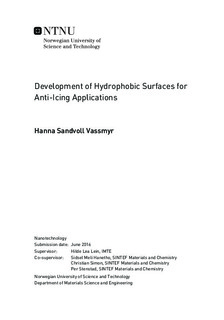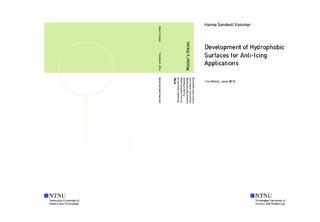| dc.description.abstract | Icing is a problem for several industries, and current methods for removal of ice have several difficulties as they are time consuming, energy intensive and may be environmentally harmful. A better solution to the icing problems is the introduction of an anti-icing surface which hinders ice formation and reduces ice adhesion if formed. Such surfaces have received a great deal of attention the last years, and one of the most investigated candidates is superhydrophobic surfaces. Such surfaces offer several advantages as they repel water, reduce the probability of ice forming due to low contact area, and can reduce ice adhesion, but their durability and performance under icing conditions have been questioned.
In this work superhydrophobic surfaces, exhibiting contact angles above 150 degree and roll-off angles lower than 10 degree, on steel have been produced by a simple and scalable method. The substrates have been sandblasted with both fine and coarse sand and SiO2-nanoparticles have been deposited, yielding a hierarchical surface structure. The surface chemistry has been altered by the addition of a hydrophobic coating layer based on the precursor 1H,1H,2H,2H-perfluorooctyltriethoxysilane. The method for depositing both nanoparticles and the hydrophobic top layer has been optimized by a systematic investigation of several coating techniques, including dip coating, spray coating, spin coating and vapor deposition. The surface with the best superhydrophobic characters was achieved when spray coating of nanoparticles was done on a steel surface sandblasted with fine sand, and the top layer was deposited by dip coating. The surface achieved a contact angle of 158 +- 2 degree with distilled water, a roll-off angle of 8 +- 2 degree and contact angle hysteresis of 19 +- 3 degree.
Icing characteristics of the surfaces produced have been tested in an environmental chamber, where the barrier against ice formation, the delay of ice formation at -10 degree C and the cyclic icing/de-icing character have been investigated. The sample showing the best hydrophobic characteristic also showed the highest barrier against ice formation with a minimum temperature of -14.8 degree C. However, other samples showed longer freezing delays (longer than 1 hour) and in general no direct correlation between hydrophobic properties and anti-icing properties was found. In addition, the hydrophobic character of the surfaces was found to depend a lot on the humidity and temperature, and no samples showed contact angles above 150 degree when cooled down to 5 degree C. | |

